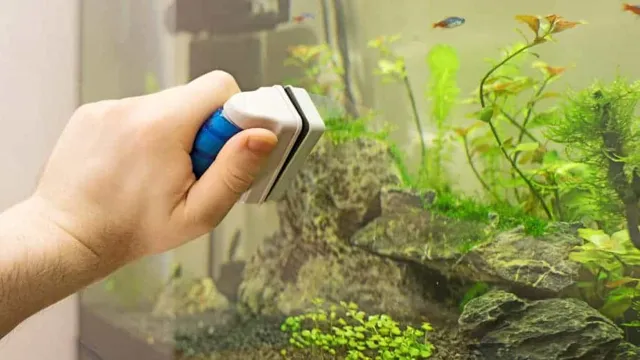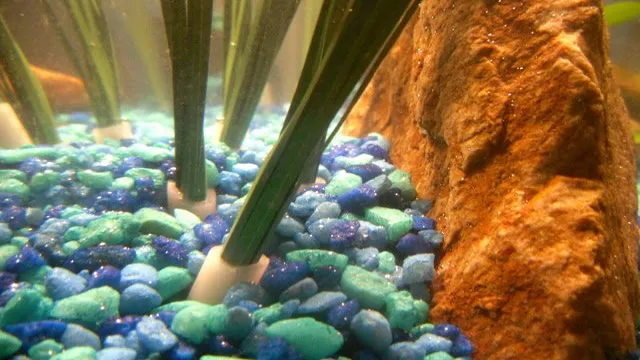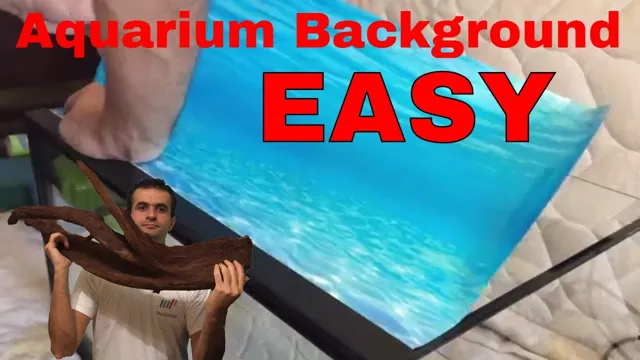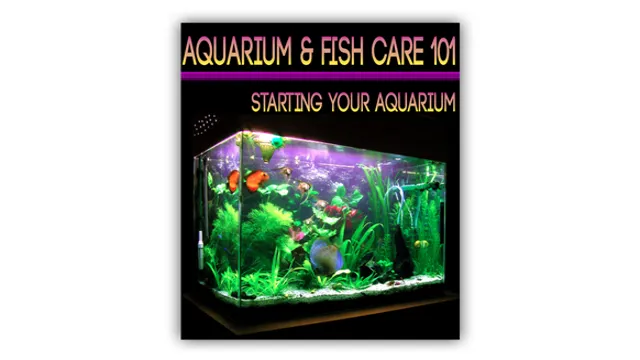If you love the idea of adding greenery to your home but don’t have a lot of space, then a terrarium may be the perfect solution. And what better way to create one than by using an old aquarium? Not only is it an affordable alternative, but it’s also an incredibly creative way to repurpose an otherwise unused object. Ready to get started on your very own DIY terrarium? Let’s dive in and explore how to make a terrarium from an aquarium!
Gather Materials
So, you want to make a terrarium from an aquarium? Great idea! First things first, you’ll need to gather the necessary materials. Here’s a quick checklist to get you started: an empty aquarium (of course), potting soil, activated charcoal, small rocks or pebbles, decorative moss or rocks, and plants that thrive in a humid environment (such as ferns or succulents). You may also want to consider adding a small water feature or little figurines for some extra personality.
It’s important to make sure that all of your materials are clean and free of any dirt or debris before you begin assembling your terrarium. By gathering all of your materials ahead of time, you’ll be able to see if you are missing anything before you start working. So, go ahead and start gathering – your beautiful new terrarium is just a few steps away!
Aquarium
Aquarium enthusiasts agree that half of the fun comes from gathering the materials needed to create the perfect underwater environment. Whether creating a freshwater or saltwater aquarium, the process starts with a tank, filter, heater, and substrate. From there, the fun begins as you choose your plants and decorations.
Some hobbyists prefer live plants while others opt for fake plants, coral, and rocks. Once you’ve decorated, give some thought to the fish and/or invertebrates you want to add. Different species have different needs and require different water conditions, so research is key to ensure compatibility.
By taking the time to gather the right materials and customize your aquarium, you can create a vibrant, healthy, and beautiful underwater world for you and your aquatic pets to enjoy.
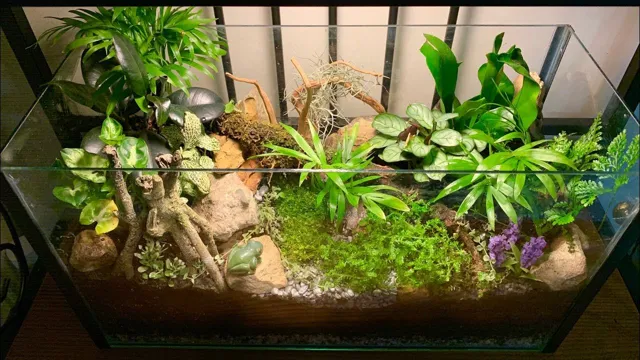
Soil
Soil is a critical component of healthy gardening, and you can’t grow plants without it. A good soil mix should be rich in nutrients, well-draining, and moist, with a pH level that’s within the ideal range for your chosen plants. When it comes to gathering materials for creating your soil mix, there are several options available.
You can start by collecting a variety of materials, such as garden soil, compost, and peat moss. Each of these materials contributes to the overall texture and nutrient content of the soil, so you’ll want to use them in the right proportions. You might also consider adding perlite, vermiculite, or sand to improve drainage.
Your local garden center can help you find the right materials, or you can even create your compost by composting kitchen scraps and yard waste. In the end, the trick to creating a healthy, productive garden is to gather the right materials for your soil mix and balance them precisely.
Gravel
When it comes to creating a gravel pathway, gathering the right materials is key. One of the most important components of a gravel path is the gravel itself. You’ll want to choose a type of gravel that is durable enough to withstand foot traffic but also aesthetically pleasing.
Popular options include pea gravel, crushed stone, and river rock. Additionally, you’ll need a fabric weed barrier to prevent weeds from growing through the pathway and a base layer of compacted gravel or sand to provide stability. Make sure to accurately measure the area you want to cover so you can purchase the correct amount of materials.
Taking the time to gather the right materials and preparing the area will ensure a long-lasting and attractive gravel pathway.
Activated Charcoal
Activated charcoal is a versatile substance that can be used for a variety of purposes, from treating poisonings and overdoses to purifying water and air. If you are interested in experimenting with activated charcoal, the first step is to gather your materials. You will need activated charcoal powder, which can be purchased online or at some health food stores.
You may also want to invest in a set of gloves and a face mask to protect yourself from the fine black powder. In addition, you will need a container to store your activated charcoal, such as a glass jar with a tight-fitting lid. Once you have all of your materials, you can start exploring the many uses of activated charcoal.
Whether you are using it to brush your teeth, filter your water, or detoxify your body, activated charcoal has the potential to be a powerful tool in your natural health toolkit. So why not give it a try and see what benefits you can reap?
Small Plants
When it comes to creating a small plant arrangement, gathering materials is the first step to take. Choosing the right pot or container is crucial, as it can affect not only the look of your plants but also their health. Make sure the container you choose has adequate drainage to prevent water from pooling at the bottom.
You can opt for ceramic, clay, or plastic pots, depending on your preference. Next, select the plants you want to include in your arrangement. Choose plants with similar growing conditions, such as lighting and watering needs, for the best results. (See Also: How to Make Driftwood for Aquarium at Home: A Step-by-Step Guide)
Additionally, you’ll need potting soil, which should be suitable for the plants you’re using. Finally, don’t forget about embellishments like pebbles, moss, and decorative rocks to give your mini garden a personalized touch. With these materials in hand, you’ll be well on your way to creating a beautiful small plant arrangement that will liven up any space.
Decorations
When it comes to decorating your space, the first step is to gather all the necessary materials. This includes things like paint, wallpaper, or fabric, as well as any tools you may need, such as brushes, rollers, and adhesive. You’ll want to start by deciding on a color scheme or theme for your space, so that you can choose materials that will complement each other.
Once you’ve gathered your materials, it’s time to start planning out how you want to decorate your space. You can begin by making sketches or mood boards to help you visualize how everything will come together. Don’t be afraid to experiment with different materials or design elements until you find the perfect combination that suits your style and personality.
With a little bit of creativity and some careful planning, you’re sure to create a beautiful and unique space that you’ll love spending time in.
Prepare the Aquarium
If you’re looking to create a unique and beautiful terrarium, using an aquarium can be a perfect choice. To start, choose an aquarium that’s big enough for the plants you want to use and make sure it’s thoroughly cleaned before you begin. Next, you’ll need to add some drainage material to the bottom to prevent water from accumulating and causing root rot.
Gravel, rocks, or even charcoal can all work well for this. Then, add some potting soil on top of the drainage material to create a layer that’s at least a few inches thick. You can use your hands or a small tool to create small holes where you’ll place your plants.
Be sure to choose plants that will thrive in the conditions your terrarium will provide, such as those that prefer high humidity. Finally, add any decorative elements you’d like, such as rocks, driftwood, or moss, to create the perfect finishing touch. With a little bit of work, your aquarium can be transformed into a stunning terrarium that you’ll love to display in your home.
Clean the Aquarium
Preparing the aquarium properly is crucial for the overall health and well-being of your fish. First, remove everything from the tank, including decorations, gravel, and plants. These items should be cleaned thoroughly with hot water and vinegar before being returned to the tank.
Next, fill the tank halfway with fresh water that has been treated with a water conditioner to remove any harmful chemicals. Allow it to sit for at least 24 hours before adding any fish. During this time, use a filter to circulate the water and maintain a stable temperature.
Once the tank is ready, it’s time to introduce your fish to their clean and healthy home. Remember, regular maintenance, including partial water changes and regular cleanings, is essential to maintain the cleanliness of the aquarium and keep your fish happy and healthy. So, if you want to ensure that your fish thrive and live a long and healthy life, follow these preparation steps and maintain a regular cleaning schedule.
Add Gravel and Charcoal
Preparing your aquarium is a crucial step in ensuring the health and longevity of your aquatic pets. Adding gravel and charcoal to your aquarium is one of the first steps in setting up your tank. Gravel not only provides a natural and attractive substrate for your aquarium, but it also aids in biological filtration by providing a surface for beneficial bacteria to grow.
Charcoal, on the other hand, helps to remove impurities and toxins from the water, making it crystal clear and safe for your fish. To add these materials, first, rinse the gravel well to remove any dust or debris. Then, spread it evenly across the bottom of the tank to a depth of around 2-3 inches.
Next, add a layer of activated charcoal on top of the gravel. The thickness of the layer will depend on the volume of your tank, but a general guideline is to use a half cup of charcoal for every 10 gallons of water. Be sure to rinse the charcoal thoroughly before adding it to the tank and replace it every few weeks to maintain its effectiveness.
With your aquarium now fully prepared, it’s time to add water and begin the exciting journey of creating a thriving aquatic environment for your finned friends!
Add Soil
Adding soil is an important step in preparing the aquarium for your aquatic friends. It not only serves as a natural and organic substrate for plants but also helps in maintaining a balanced ecosystem for your pets. Choose a soil specifically made for aquariums and rinse it thoroughly before adding it to the tank.
The soil should be spread out evenly over the bottom of the tank, with a thickness of at least one inch. This will create a suitable environment for beneficial bacteria to grow, which will help in the biological filtration of the tank. Additionally, the soil will provide vital nutrients for plant growth ensuring their healthy and robust growth. (See Also: How to Make a Nano Planted Aquarium: Step-by-Step Guide to Create a Lush Green Miniature Ecosystem)
While adding soil, be careful not to disturb the natural balance of the aquarium, and avoid overfeeding to avoid unnecessary buildup of organic matter. Adding soil is a fundamental step in preparing the aquarium and is crucial for maintaining a healthy aquatic life.
Plant the Terrarium
Now it’s time to add some life to your aquarium terrarium! Start by selecting plants that will thrive in the specific environment you’ve created. Choose plants of differing heights and textures to create interest within the terrarium. Begin by adding a layer of activated charcoal to the bottom of the aquarium to aid in filtration.
Then add a layer of pebbles and sand to mimic a natural ecosystem. Carefully add the plants one by one, making sure to space them out appropriately and arranging them by height for maximum visual interest. Don’t forget to water the plants sparingly, as the enclosed environment allows for moisture retention.
Finally, add decorative rocks or other accessories for a finishing touch. Congratulations, you’ve successfully created a beautiful and unique terrarium from an aquarium!
Choose and Arrange Plants
Once you’ve got all your plants and decorative elements ready, it’s time to start planting your terrarium! Before you begin, think about how you want to arrange your plants inside the container. You can opt for a symmetrical layout, or create an organic feel by placing them randomly. For a layered effect, start with a layer of pebbles at the bottom to aid drainage, followed by a layer of activated charcoal to absorb any excess moisture.
Then add a layer of potting soil and begin planting your chosen plants. As you add each plant, be sure to gently press the soil around the roots to secure it in place. Don’t forget to leave enough room between each plant so they have enough space to grow.
Once all your plants are in place, add a final layer of decorative gravel or moss to create an eye-catching finishing touch. With a little care and maintenance, your newly planted terrarium is sure to fill your home with a burst of natural beauty and be a great conversation starter.
Add Decorations
Now that your terrarium is ready with a base layer and substrate, it’s time to add some decorations to give it a unique flair. There are several decoration options available, ranging from stones, miniature figurines, driftwood, or shells to give your terrarium an appealing texture and depth. You can also add live decor like mosses, ferns, and small succulents to create a natural environment.
Before adding plants, place your decorations in your desired arrangement, keeping in mind the size of the terrarium. Start by arranging your larger pieces first to ensure that you have enough space for the plants. Be sure to place your decorations in a way that does not cause overcrowding or cover the base layer too much.
Once you are satisfied with your arrangement, it’s time to add the final touch: the plants.
Care for the Terrarium
Making a terrarium out of an aquarium is not as complicated as it may seem, but maintaining it requires some diligence. First, you need to set up the terrarium with a layer of gravel, activated charcoal, and soil that suits the plants you plan to keep inside. Once you have your plants, it is important to water them sparingly, as overwatering can lead to root rot and the buildup of harmful bacteria.
Additionally, you can support the growth of your plants by providing adequate lighting and making sure the terrarium receives the right amount of sun exposure. Lastly, it’s important to periodically check on the plants and remove any dead leaves or debris that can attract pests or decay. With some patience and care, your DIY terrarium can thrive and add a touch of nature to your home.
So why not give it a try and create your very own mini-ecosystem?
Water and Light Needs
When it comes to caring for your terrarium, understanding the water and light needs of your plants is crucial. Overwatering or underwatering can quickly lead to root rot and eventually kill your beloved plants. On the other hand, not providing enough light can cause stunted growth and wilted leaves.
It’s important to do your research and determine the specific needs of each plant in your terrarium. Some plants may prefer more moisture and low light, while others require bright, indirect light and less watering. It’s a delicate balance, but with proper attention and care, your terrarium can thrive. (See Also: How to Determine If Your Aquarium Needs Resealing: Easy Tips and Tricks.)
Don’t be afraid to experiment and adjust the levels of water and light to find the right balance for your plants. Remember, each plant is unique and may require different care. By providing the perfect environment for your terrarium, you can enjoy a stunning display of nature in your home.
Maintenance Tips
As an owner of a terrarium, it’s important to care for it properly to ensure its longevity. This means performing routine maintenance to keep it clean and healthy. One key aspect of terrarium care is maintaining the correct amount of moisture.
Depending on the type of plants in your terrarium, you may need to mist the soil or leaves on a regular basis. Be sure to monitor the humidity levels within the enclosure to prevent mold and bacterial growth. Another important aspect of terrarium maintenance is pruning any overgrown plants to prevent overcrowding and maximize airflow.
Regularly removing any dead or decaying plant matter will also help keep your terrarium healthy and pest-free. Remember, a little upkeep goes a long way in keeping your terrarium looking its best!
Conclusion
In conclusion, making a terrarium from an aquarium is a fun and creative way to bring a little bit of the great outdoors inside your home. By following these steps, you will be able to create a mini ecosystem that requires minimal upkeep and adds a beautiful touch to any space. Plus, think of it as an aquarium for plants – providing a safe, comfortable environment for them to thrive.
So get your hands dirty and try your hand at creating your very own terrarium – your friends will be green with envy at your newfound gardening skills!”
FAQs
What materials do I need to make a terrarium from an aquarium?
You will need an aquarium, soil, rocks, moss, plants, and any desired decorations.
How do I prepare the aquarium before making the terrarium?
Clean the aquarium thoroughly with water and a mild detergent. Rinse it well and let it dry completely.
Do I need to add drainage to the aquarium before making the terrarium?
Yes, add a drainage layer made of rocks or gravel at the bottom of the aquarium to prevent water from accumulating.
Can I use any type of soil for my terrarium?
It is recommended to use a soil mix that has good drainage and is suitable for the plants you have chosen.
What types of plants are best for a terrarium?
Choose plants that thrive in a humid environment, such as ferns, mosses, and succulents.
How often do I need to water my terrarium?
Water your terrarium sparingly, only when the soil becomes dry to the touch. Overwatering can lead to root rot and other problems.
What should I do if my terrarium becomes too humid?
If your terrarium is too humid, remove the lid or place it in a drier location. You can also add more ventilation to the aquarium.



